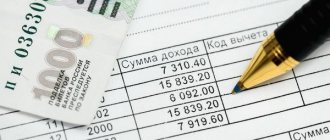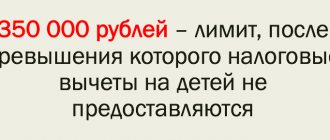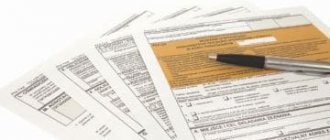What is “VAT deductible”
The total amount of VAT that a taxpayer must pay to the budget can be reduced by tax deductions. In Art. 171 of the Tax Code of the Russian Federation there is a complete and closed list of transactions for which VAT can be deducted. The benefit is valid in the following cases:
- VAT has been paid on goods, works, services, property rights (hereinafter referred to as GRU), which are planned to be resold or used in activities subject to VAT.
- VAT is calculated and paid when importing goods and materials into the Russian Federation or when fulfilling the obligations of a tax agent.
- Construction and installation work was completed for our own needs.
- Contractors submitted VAT when carrying out assembly and disassembly, installation and dismantling, capital construction or liquidation of fixed assets.
- An advance has been received or issued for future payment.
- After the sale, the price or quantity of goods shipped, work performed, services provided, or property rights changed.
- The goods were returned to the seller or a buyback was carried out.
- A contribution to the authorized capital was received in the form of property, property rights or intangible assets.
- VAT is paid on travel expenses.
- VAT is compensated using the tax free system.
- A foreign organization has charged VAT for the purchase of electronic services.
The procedure for applying tax deductions
The procedure for applying tax deductions for VAT is prescribed in Art. 172 of the Tax Code of the Russian Federation. It also indicates the nuances of applying this procedure.
In case of return or refusal of goods (clause 4 of Article 172 of the Tax Code of the Russian Federation), VAT is deducted in full after the corresponding adjustment operations are reflected in the accounting records, but no later than one year from the date of return or refusal.
VAT restored by a shareholder (participant, shareholder) on property received as a contribution to the authorized capital is subject to deduction after the property is registered (clause 8 of Article 172 of the Tax Code of the Russian Federation).
If the cost or volume of goods shipped increases (clause 10 of Article 172 of the Tax Code of the Russian Federation), the tax calculated by the buyer is deducted using adjustment invoices. Important: there must be a document that confirms the buyer’s consent to a change in price or volume. This could be a contract or an agreement.
Who can apply VAT deductions
Only VAT payers can take advantage of the deduction - that is, organizations and entrepreneurs on OSNO or Unified Agricultural Tax.
The remaining special regimes are exempt from VAT, so tax cannot be deducted on them. Instead, tax amounts are included in the cost of purchased goods or separately included in expenses.
To accept VAT as a deduction, you must comply with all the conditions from Art. 171 Tax Code of the Russian Federation. If this is not done, during an audit the tax office may deprive the right to deduction and charge additional input tax. In general, VAT can be deducted if four conditions are simultaneously met:
- VAT is presented by the supplier;
- purchased GWS will be resold, used in VAT-taxable transactions or exports;
- purchased GWS are accepted for accounting;
- the supplier presented a correctly executed invoice or UPD.
In fact, it is not necessary to pay VAT to the supplier to qualify for the deduction. But there are exceptions, for example, VAT on the cost of imported goods can be deducted only after paying the tax at customs.
Let's consider the conditions in more detail.
Condition 1. VAT is presented by the supplier
In addition to the price of sold GWS, the supplier must submit VAT for payment. The tax amount is reflected in the contract, invoice and primary sales documents.
When the supplier has not highlighted VAT in the documents, it cannot be calculated and deducted independently. This happens, for example, when working with counterparties on the simplified tax system or foreign sellers.
But if the buyer performs the duties of a tax agent, he must independently calculate and pay VAT to the budget.
Keep records of exports and imports in the Kontur.Accounting web service. Simple accounting, payroll and reporting in one service
Condition 2. Purchased GWS will be resold, used in VAT-taxable transactions or in exports
You cannot claim a deduction for goods and services that are used in non-VAT-taxable transactions. In this case, the input tax is included in the cost of the purchased GWS.
The deduction can be used only if input VAT is paid on an object that is involved in taxable transactions or export works and services (excl. Article 149 of the Tax Code of the Russian Federation).
If you initially bought goods for use in non-taxable transactions, but then decided to resell them or use them in taxable activities, VAT can be deducted. Conversely, when purchasing goods for use in taxable transactions and actual use in non-taxable ones, the VAT accepted for deduction must be restored.
If during the reporting quarter you had both taxable and non-taxable VAT transactions, start keeping separate records. Take part of the tax on taxable transactions as a deduction, and include the rest of the input VAT in the cost of purchases.
Condition 3. Purchased goods and materials are accepted for accounting
Purchased goods and materials must be capitalized according to accounting rules, only then can input VAT be deducted. Capitalization must be confirmed by documentation - a correctly executed primary document.
GWS can be considered capitalized, the cost of which is reflected in the accounting accounts. For example, goods for resale should be reflected on account 41, work and services - on accounts 20, 44, etc.
Also fill out the primary registration form for the goods and services accepted for registration. These can be standard documents or independently developed forms: invoices, receipt orders, acts, invoices, etc.
Condition 4. The supplier presented a correctly executed invoice or UPD
You must receive an invoice or a universal transfer document (UDD) from the supplier. If there are no invoices, they are issued with violations or are not reflected in the VAT return, do not accept input tax as a deduction (Article 172 of the Tax Code of the Russian Federation, letter of the Federal Tax Service dated October 21, 2013 No. ММВ-20/3/96).
An invoice or UPD is not always required (clauses 2.1, 3, 6–8 of Article 171 of the Tax Code, letter of the Ministry of Finance dated September 16, 2019 No. 03-07-14/71091). This is not necessary when importing goods, receiving a contribution to the management company, VAT compensation for a foreigner, or purchasing electronic services from foreign companies. In such cases, invoices can be replaced with other documents. For example, for property on account of a contribution to the authorized capital, these could be acts OS-1, OS-1a, etc. To do this, the documents also need to indicate the amount of VAT recovered by the participant.
Additional terms
In order to deduct VAT on some transactions, additional conditions must be met. For example, to deduct VAT, which you must pay yourself, the tax must be transferred to the budget. To deduct VAT on property against a contribution to the management company, the participant must restore the tax to the budget.
Also, for some transactions, special conditions for accepting tax for deduction are established, and all four listed above do not apply. For example, to deduct VAT on an advance payment, the buyer needs an invoice from the seller, an agreement with the condition of the advance and a payment document for its payment. In order for the seller to be able to deduct VAT on the advance received, he must ship the goods or return the advance to the buyer.
Products received are recorded on an off-balance sheet account
The Ministry of Finance traditionally prohibits accepting deductions for material assets that are recorded in off-balance sheet accounts. They explain their position as follows: since the company has not put the product on its balance sheet, it means that it does not have ownership rights to it. But goods belonging to another person cannot be disposed of. In particular, it is impossible to use them in transactions subject to VAT. Thus, one of the main conditions for the deduction provided for in Article 171 of the Tax Code of the Russian Federation is not met (letter of the Ministry of Finance of Russia dated August 22, 2016 No. 03-07-11/48963; see “The buyer does not have the right to claim a VAT deduction on goods recorded on an off-balance sheet account” ).
True, the judges do not share this point of view. The resolution of the AS of the Ural District dated November 19, 2015 No. F09-7998/15 states that the Tax Code of the Russian Federation does not correlate the right to deduction with the account on which the goods are recorded. For this reason, the use of an off-balance sheet account cannot be considered a reason to eliminate the deduction.
However, ignoring the position of the Ministry of Finance and accepting such a deduction is quite risky. Most likely, you will have to defend it in court, and this will require a lot of effort, time and money. In our opinion, it is necessary to follow this path only in cases where the size of the deduction is very significant for the company.
When can you claim a VAT deduction?
The deduction can be submitted in the quarter in which all mandatory conditions are met. Example. Algorithm LLC purchased goods for resale and capitalized them on July 1 (3rd quarter). At the same time, the supplier issued an invoice with the allocated amount of VAT on June 30 (2nd quarter). Algorithm LLC fulfilled the last condition (accepted goods for accounting) only in the 3rd quarter, so the organization can declare a deduction no earlier than in the declaration for the 3rd quarter.
If an organization had received goods on June 30 and received an invoice on July 24, it could have taken advantage of the deduction in the 2nd quarter. There is an important condition here: the invoice must be received before the 25th of the month following the quarter, that is, before the deadline for filing the declaration.
VAT deductions for past periods can be claimed within three years from the date of capitalization. When returning an advance payment or goods, the deduction can be claimed within a year; the three-year period does not apply in this case.
Right to deduction
Tax deductions for VAT are made on the basis of the seller's invoice for the goods in the tax period in which they were registered by the taxpayer. Do not forget about the first condition - goods must be used for operations subject to VAT.
The right to deduct VAT remains for three years from the end of the reporting period in which all three of the above conditions are met.
The invoice must be issued in accordance with Decree of the Government of the Russian Federation dated December 26, 2011 No. 1137. The Tax Code (clauses 5, 5.1, 6 of Article 169 of the Tax Code of the Russian Federation), in addition, establishes that the invoice must necessarily indicate :
- date of preparation and serial number of the invoice;
- name, address and tax identification number of the supplier and buyer;
- name and address of the sender and recipient of the cargo;
- name of goods (works, services) and units of measurement;
- signatures of the head and chief accountant of the organization or other authorized persons.
The invoice is replaced by the UTD - a universal transfer document. UPD completed in accordance with Art. 9 of the Law “On Accounting” dated December 6, 2011 and Art. 169 of the Tax Code of the Russian Federation, is used to present VAT for deduction (letter of the Federal Tax Service of Russia dated October 21, 2013 No. MMV-20-3 / [email protected] ).
In addition to invoices, in some cases other documents may be required that confirm payment of VAT amounts.
Calculation of VAT for deduction
To calculate VAT deductible, add up all VAT on your transactions listed in Art. 171 Tax Code of the Russian Federation. However, remember that all conditions must be met to claim a deduction; check this before including the tax on the transaction in the calculation.
Keep records of exports and imports in the Kontur.Accounting web service. Simple accounting, payroll and reporting in one service
The tax office checks all VAT claimed for deduction for compliance with the conditions, and another criterion is its amount. Inspectors have their own standards for deductions. If yours turns out to be larger, tax officials may require clarification or come with an audit.
There is no exact data on how the Federal Tax Service considers the “Safe Deduction”. Typically one of two methods is used:
- Method 1. The Federal Tax Service calculates the share according to declarations for the year and compares it with the threshold value of 89 percent.
- Method 2. The Federal Tax Service calculates the share according to the declarations for the quarter and compares it with the average share of deductions by region.
Calculate your share of deductions using the formula:
Share of deductions = All deductions (p. 190 section 3) / Accrued VAT (p. 118 section 3) × 100%
If the percentage of deductions is greater than the safe amount, you can carry them forward to later quarters or claim them in installments over three years. Both transfer and division into parts are valid only for deductions from clause 2 of Art. 171 Tax Code of the Russian Federation.
Who is entitled to deduction
The following taxpayers have the right to apply VAT deductions (clause 1 of Article 143 of the Tax Code of the Russian Federation):
- organizations;
- entrepreneurs;
- persons recognized as VAT taxpayers in connection with the movement of goods across the customs border of the Customs Union, determined in accordance with the customs legislation of the Customs Union and the legislation of the Russian Federation on customs affairs.
A VAT defaulter can also deduct the tax (clause 8 of Article 145, clause 6 of Article 346.25, clause 9 of Article 346.26 of the Tax Code of the Russian Federation). This becomes possible when an organization or individual entrepreneur has lost the right to:
- to use special regimes;
- exemption from taxpayer obligations under Art. 145 of the Tax Code of the Russian Federation.
From the quarter in which this right is lost, the organization or individual entrepreneur must charge and pay VAT. This quarter, the payer has the right to claim VAT for deduction if the above three conditions are simultaneously met:
- availability of an invoice;
- posting of goods;
- use of goods in activities subject to VAT (if the goods were not used during non-use of VAT).
How to reflect the VAT deduction in the declaration
The amounts of VAT to be deducted are reflected in lines 120-190 of section 3 of the VAT return. In lines 120-185, the deduction is distributed by type. And in line 190 the total amount of deduction for the quarter is calculated; for this, the values from lines 120-185 are added together.
Next, from line 118, which indicates the amount of tax including recovery, subtract line 190. This way you will receive the amount of VAT payable or refundable. If the difference between lines 118 and 190 is greater than 0, reflect the VAT payable in line 200, if less, reflect the VAT payable in line 210.
Results
VAT deduction is the amount of tax billed by the seller, by which the taxpayer has the right to reduce the amount of calculated VAT payable. But in order to claim input VAT for deduction, it is important to take into account all the conditions prescribed by the Tax Code: register goods, use them in VAT-taxable activities and present correctly completed documents. Tax authorities pay special attention to checking input invoices, because if there are errors in these documents, VAT will be excluded from the amounts to be reimbursed.
Find out what is the safe percentage of VAT deductions in your region.
Sources: Tax Code of the Russian Federation
You can find more complete information on the topic in ConsultantPlus. Free trial access to the system for 2 days.
Postings for registering VAT deductions
| Wiring | Operation |
| Dt 19 Kt 60 | Input VAT on goods, works, services, property rights is reflected |
| Dt 68 Kt 19 | Input VAT is accepted for deduction |
| Dt 76 Kt 68 | VAT has been charged on advance payments towards future deliveries |
| Dt 68 Kt 76 | Accepted for deduction of VAT on an advance received previously from a buyer or an advance paid to a supplier |
| Dt 19 Kt 68 | VAT accepted for deduction has been restored |
| Dt 91-2 Kt | Recovered VAT is written off as expenses |
Keep VAT records in the Kontur.Accounting web service. The service will indicate which documents need to be completed and which transactions need to be monitored in order to avoid fines and reduce VAT payable. The system makes it easy to keep records, payroll and report via the Internet. The first two weeks in Accounting are free for all new students.
VAT deduction on advance invoices
Submitting VAT for deduction is an operation that requires strict evidence. The buyer receives the right to deduct VAT only if he has an invoice that is correct in all respects. If you made an advance payment to your supplier, he must also issue you an advance invoice. The possibility of such a deduction is provided for in clause 9 of Art. 172 of the Tax Code of the Russian Federation. But in order for the buyer to take advantage of the “advance” deduction, he must have:
- correctly executed advance invoice;
- documents confirming the fact of transfer of the advance;
- the corresponding agreement, which contains the conditions for prepayment.
Please note: if a non-cash form of payment is used, the buyer will not be able to apply a VAT deduction, since in this case there will be no confirming payment document for the prepayment. In addition, invoices that are received for prepayment amounts - full or partial, with non-cash payment options cannot be registered in the purchase book, but the total amount of VAT deductible is transferred to the tax return from it.
See also: “Acceptance for deduction of VAT on advances received.”






